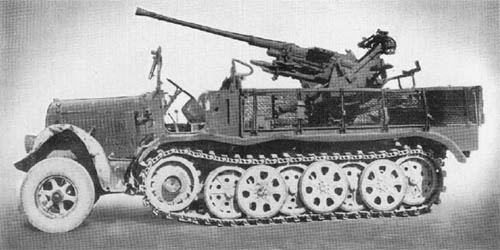
The 3.7 cm Flak 36 has also been mounted on the chassis of the 8-ton medium prime mover described on page 54. Data on the weapon may be found on page 130.1.
German: p. 54.1 (April 1, 1945)

The 3.7 cm Flak 36 has also been mounted on the chassis of the 8-ton medium prime mover described on page 54. Data on the weapon may be found on page 130.1.
German: p. 54.1 (April 1, 1945)
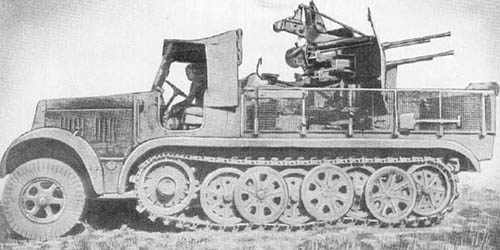
The 2 cm Flakvierling 38 has been mounted, as illustrated above, on the chassis of the 8-ton medium semitrack prime mover described on page 54. Details of the weapon and its performance may be found on page 133.
German: p. 54.1 (April 1, 1945)
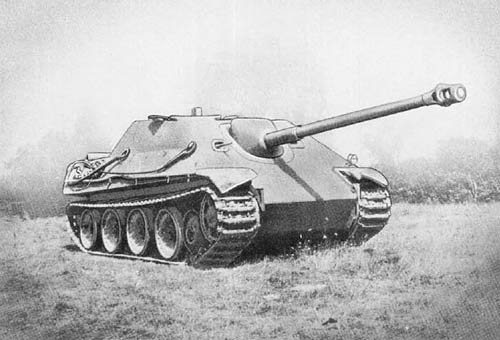
The standard Model A Panther chassis is used for building this vehicle. The vehicle embodies all of the engineering principles and methods of design accumulated by the Germans up to the time of its production, and is quite effective as an antitank or assault weapon.
The hull and fighting compartment are of all welded construction. The fighting compartment is 45 inches in height at the front and 57 inches at the rear. The length of the roof is 93 inches and the width 72 inches.
The steering mechanism, “one radius steering,” is new. It is unnecessary to engage the transmission in order to turn or traverse the tank through 360 degrees. The use of either steering lever will traverse the tank in a small radius or on the spot. The annulus gear of each of the two epicyclics is driven by the transmission output shaft and is subject to seven speeds forward and one reverse. The sun gears are held stationary on the straightaway by steering brakes. In making a turn, the inside sun gear is released to rotate backward for a sharper turn, the inside sun gear is driven by engagement through a steering clutch with the engine.
The vehicle is armed with the 8.8 cm Pak 43/3 gun in a massive cast steel mantlet which is flexibly mounted in a cast steel ring welded to the front plate. Traverse is 11 degrees. Stowage is provided for 29 rounds of each of two types of ammunition. One M.G. 34 is ball mounted in the front plate to the right. Driver’s vision is by periscope. Fuel capacity is 193 gallons, of which 34 gallons are held in auxiliary.
SPECIFICATIONS
| Weight | 45 tons | |
| Length (overall) Including gun | 28 ft., 4 ins. | |
| Excluding gun | 22 ft., 8 ins. | |
| Width (overall) | 10 ft., 10 ins. | |
| Height (overall) | 9 ft., 10 ins. | |
| Ground clearance | 21 ins. | |
| Tread centers | 8 ft., 7½ ins. | |
| Ground contact | 12 ft., 9½ ins. | |
| Width of track | 26 ins. | |
| Pitch of track | 6 ins. | |
| Track links | 67 | |
| Fording depth | 67 ins. | |
| Theoretical radius of action | ||
| Roads | 124 miles | |
| Cross-country | 62 miles | |
| Speed | ||
| Roads | 34 m.p.h. | |
| Cross-country | 15-18 m.p.h. | |
| Armor | ||
| Front plate | 80 mm at 55° to the vertical | |
| Sides | 45 mm at 30° to the vertical | |
| Rear | 40 mm at 30° to the vertical | |
| Top | 17 mm at 85° to the vertical | |
| Armament | 8.8 cm Pak 43/3 (MV 3.280 f/s, A.P.C.B.C.), M.G. 34 | |
| Ammunition (Rds.) | 58 (8.8 cm) | |
| Engine | Maybach HL 230 P 30 V12 gasoline | |
| Transmission | Synchromesh 7 speeds forward, 1 reverse | |
| Steering | One radius double drive epicyclic | |
| Crew | 5 |
German: p. 38.1 (August 1, 1945)
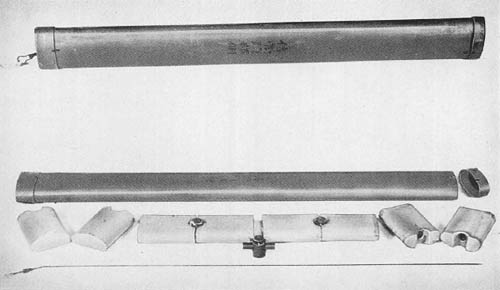
This Japanese land mine, of Naval origin, is usually found buried in landing strips. Almost any vehicle will activate the mine, but its use as an anti-personnel device is limited since a pressure of approximately 336 pounds is necessary to set it off.
The mine consists of an oval shaped tube of sheet metal with a cap on both ends; an explosive charge comprising eight blocks of picric acid, each cast in a paper container and coated with paraffin; and four percussion type fuzes.
The picric acid blocks which are flattened on one side do not fill the mine completely. The space between the flat side of the blocks and the wall of the case accommodates the protruding heads of the fuzes which are inserted between blocks.
The percussion type fuze consists of a cylindrical body which houses the striker release plunger, a booster housing, and a striker housing. The two latter parts are identical in external appearance and screw into the sides of the main body diametrically opposite each other.
The striker release plunger, a split pin with an enlarged flat head, is positioned in the fuze body by a copper shear wire. A second hole 90 degrees from the shear wire hole accommodates a safety wire. The lower end of the plunger is split by a slot, the width of which is increased on the inner end.
The mine is held in an unarmed position by the safety wire which is inserted through a hole in one of the end caps, and extends the entire length of the mine. A spring clip on the cap holds the wire in place. When the mine is to be put into operation, the safety wire is removed and a burying plug is screwed into the hole in the cap to make the assembly waterproof. A thick tarry substance is applied to-the seams around the end caps probably for the same purpose.
SPECIFICATIONS
| Length (overall) | 36 ins. | |
| Diameter (oval) | 3.35 x 1.8 ins. | |
| Total weight | 10.58 lbs. | |
| Weight of mine | 4.63 lbs. | |
| Weight of filling | 5.95 lbs. | |
| Weight of each explosive block | 3/4 lb. | |
| Filling | Picric acid | |
| Weight of complete fuze | .29 lb. | |
| Color | Brown outside; black lacquer inside |
Japanese: p. 308.1 (March 1, 1945)
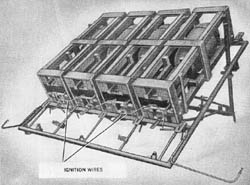 These two rocket projectors, or ramps, differ from each other only in construction details and in the material used. The Schweres Wurfgerät 40 is made of wood and weighs 115 pounds; the 41 model is of metal, weighing 243 pounds. Each is designed to carry four crates of the
These two rocket projectors, or ramps, differ from each other only in construction details and in the material used. The Schweres Wurfgerät 40 is made of wood and weighs 115 pounds; the 41 model is of metal, weighing 243 pounds. Each is designed to carry four crates of the
Either model is adjustable for elevation. Firing is accomplished by the hand electric firing system provided for the crates themselves. Maximum ranges for these projectors are identical: 2,106 yards for the
German: p. 349 (May 1, 1945)
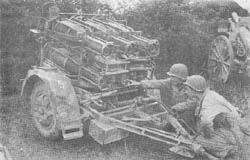 This rocket projector fires the
This rocket projector fires the
This device, which functionally does not differ from the
The firing mechanism is electric. Traverse (approximately 30°) and elevation (from 0 to 45°) are bymeans of cranks.
The piece is fired from its mounting and is held in position by two jacks in front and a small spadelike arrangement in the rear.
The equipment weighs approximately 2,460 lbs.
German: p. 349 (May 1, 1945)
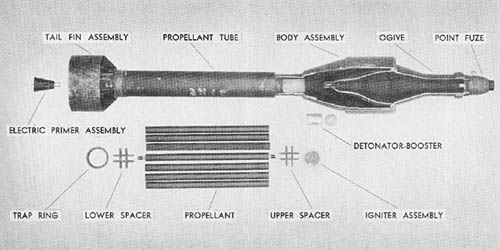
This fin stabilized rocket projectile is fired from the German counterpart of the U.S. “Bazooka” (see page 217) and has a maximum effective range of 165 yards. Eight and one-half-inch armor penetration has been obtained in static tests with a standoff of approximately 6 1/2 inches.
The complete round consists of a point fuzed high explosive, hollow charge loaded projectile assembled to a steel tube with a venturi and stabilizer assembly attached, containing an igniter, propellant and electric primer. The AZ 5095 fuze is of the point detonating type which in tests gave an approximate fuze functioning time of 0.0002 seconds (impact to detonation). The projectile assembly consists of the following stamped sheet steel parts: a body which contains the bursting charge, an adapter, a collar, a band, and a slightly heavier sheet steel nose. A detonator-booster of the German Kl. Zdlg. 34 NP type is embedded in the bursting charge to the rear of the flash tube. The bursting charge is cyclotol (41.2% TNT, 58.8% cyclonite) weighing
A new type of ammunition, the R. Pz. B. Gr. 4999 is reported to give good performance up to a range of 220 yards, 25° C. (77° F.).
SPECIFICATIONS
| Weight (complete, rocket as fired) | 7.26 lbs. | |
| Weight of high explosive filler | 1.47 lbs. | |
| Weight of fuze assembly | .175 lb. | |
| Weight of igniter assembly | .021 lb. | |
| Weight of propellant charge | .382 lb. | |
| Length (overall) | 25.56 ins. | |
| Diameter (external) | 3.437 ins. | |
| Burnt velocity at 50° F. (approx.) | 340 f/s* | |
| Burning distance (approx.) | 7 ft.* | |
| Fuze functioning time (approx.) | .0002 seconds | |
| Maximum pressure | 6,910 lbs. per sq. in.* | |
| Maximum thrust | 1,716 lbs.* | |
| Impulse | 87 lbs. second** | |
| Maximum effective range | 165 yds. |
*These figures are from firing a single round.
**These values doubtful; only one rocket motor was statically tested with propellant temperature 41° F.
German: p. 357 (August 1, 1945)
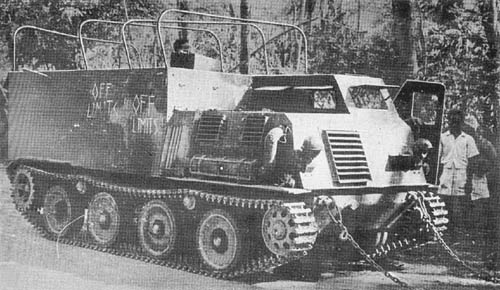
This vehicle serves as an artillery prime mover and as a personnel carrier for 24 men. It appears to be of recent manufacture, and its first known appearance in combat was during the Leyte campaign in the Philippines.
It is a full-tracked vehicle armored with 1/4-inch plate throughout. The engine which is located at the right front of the body is a 6-cylinder, in-line, valve-in-head, air-cooled diesel of a type similar to those used in the Model 2595 light tank and the combination prime mover and wrecker. Two fuel tanks provide an estimated total capacity of 50 to 60 gallons.
The tracks and suspension are of the conventional Japanese design, using dual bogie wheels and a steel center guide track. The four bogie wheels, apparently identical with those on the Model 2595 light tank, are mounted on bell cranks and are sprung by horizontal coil springs which are inclosed within the body armor with only the bogie arms exposed. There are two return rollers. The track is driven from the rear. A clutch and brake steering system is used. The transmission provides four speeds forward and one reverse. A high and low transfer case is also provided.
A mount for a 7.7 mm machine gun is located on the left front of the driver’s compartment. The vehicle does not mount a winch, but is provided with a spring mounted towing pintle for use as a prime mover. It has a capacity of from 2 to 3 tons if used as a cargo carrier. Maximum speed is reported as approximately 35 miles per hour, with exceptionally good cross-country performance due to the amount of track area in contact with the ground in relation to the weight of the vehicle.
SPECIFICATIONS
| Weight | ||
| Length (overall) | 15 ft., 9 ins. | |
| Width (overall) | 6 ft., 8 ins. | |
| Height | ||
| Ground clearance | ||
| Tread centers | ||
| Ground contact | 9 ft., 10 ins. | |
| Width of track | 10 ins. | |
| Pitch of track | 3-13/16 ins. | |
| Track links | 125 | |
| Fording depth | ||
| Theoretical radius of action | ||
| Roads | ||
| Cross-country | ||
| Speed (maximum) | 35 m.p.h. | |
| Armor (reported) | 1/4 in. | |
| Armament | 7.7 mm machine gun | |
| Ammunition (Rds.) | ||
| Engine | 6-cylinder, in-line, valve-in-head, diesel. | |
| Transmission | 4 speeds forward, 1 reverse; high and low range. | |
| Steering | Clutch and brake system | |
| Seating capacity | 24 |
Japanese: p. 18.3 (May 1, 1945)
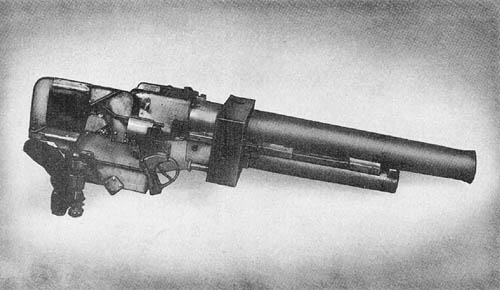
This gun, manufactured at Osaka Arsenal in 1939, is mounted on the Japanese Medium Tank Type 97. The tube, of monobloc construction, is fastened to the breech ring by twelve interrupted threads and secured by a lock on the right side of the tube. The breech ring is box-shaped. The breechblock of the vertical sliding type rides in two dovetailed slots in each side of the breech ring, and may be operated manually or semi-automatically.
The firing pin is automatically cocked when the breech is opened. The trigger, on the left side of the gunner’s shield, is protected by a trigger guard with a pistol grip. The recoil mechanism is a hydro-spring type.
The gun is mounted in the turret of the tank, and has a 360° traverse. It may also be freely elevated or traversed independently of the turret by means of two sets of trunnions. The inner vertical trunnions are set in a heavy steel bracket fitted to the cradle and permit a 5° left and right traverse. The bracket has a sighting window which may be closed for the gunner’s protection. The outer horizontal trunnions fit into another steel bracket and give approximately 11° elevation and 9° depression.
Although no sighting equipment was recovered with the gun, the appearance and location of the head rest, shoulder rest, and sight bracket indicate that a straight tube telescope is used.
SPECIFICATIONS
| Caliber | 57 mm | |
| Weight of tube and breech ring | 138 lbs. | |
| Weight (firing position) | 293.5 lbs. | |
| Length of tube and breech ring | 41 5/8 ins. | |
| Length (firing position) | ||
| Height (traveling position) | ||
| Height (firing position) | ||
| Width (overall) | ||
| Width of trail spread | ||
| Length of tube and breech ring | 41 5/8 ins. | |
| Rifling | R.H., uniform twist; approx. 1 turn in 28 1/2 cals. | |
| Length of rifling | 32.5 ins. | |
| No. of grooves | 20 | |
| Width of grooves | .25 in. | |
| Depth of grooves | .039 in. | |
| Width of lands | ||
| Muzzle velocity (shell) | ||
| Max. range (horizontal) | ||
| Max. range (vertical) | ||
| Rate of fire | 20 r.p.m. | |
| Traverse | 360° with turret and 5° right and left independent of turret | |
| Elevation | 11° | |
| Depression | 9° | |
| Length of recoil | 11 ins. | |
| Ammunition | H.E. and A.P.H.E. | |
| Wt. of projectile |
Japanese: p. 106.2 (August 1, 1945)
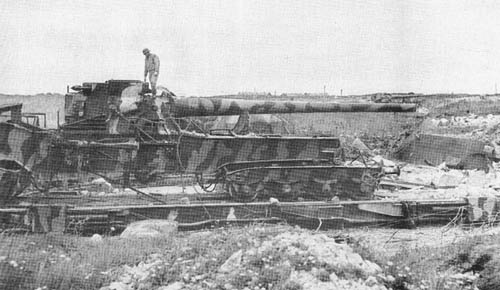
Batteries of these railway guns in concrete emplacements were found on both the Cherbourg and Brest Peninsulas in France. Equipment consisted of the gun, carriage, turntable, power plant and electrical operating unit, and ammunition car.
The piece is of the built-up type, consisting of a tube and two jackets. It is screwed into the breech ring. The breechblock is of the horizontal sliding wedge type. The hydropneumatic recoil system has two cylinders located under the carriage; the pistons are fastened to the lower end of the breech ring.
The carriage, when mounted on a turntable, has a traverse of 360 degrees; it is estimated that elevation is from 0 to 840 mils.The turntable, consisting of two sections bolted together, rotates on a central pivot and a portable circular track. Four wheels at each end of the turntable support it on the track. Electric motors are geared through these wheels to rotate the piece in azimuth. It is very similar to the 28 cm K. 5 (E) reported on page 100.2.
A small ammunition car, equipped with a removable roof, is mounted on trucks and runs on a two-rail track which is built in as a part of the turntable track.
SPECIFICATIONS
| Weight of gun | 45,500 lbs. | |
| Weight of carriage w/ gun | 189,000 lbs. | |
| Caliber | 203 mm (7.982 ins.) | |
| Weight (firing position) | 92.5 tons | |
| Length (traveling position) | 63 ft. (approx.) | |
| Height (traveling position) | 13 ft. | |
| Height (firing position) | ||
| Width (overall) | 13 ft. (approx.) | |
| Track | Std. railway gage 56 1/2 ins. | |
| Length of tube | 30 ft., 7 ins. | |
| Length of tube and breech | 32 ft., 8 1/2 ins. | |
| Length of rifling | 22 ft. | |
| Rifling | Uniform R.H. twist | |
| No. of grooves | 64 | |
| Width of grooves | 0.188 in. (approx.) | |
| Depth of grooves | .125 in. (approx.) | |
| Width of lands | ||
| Muzzle velocity (shell) | 2,800 f/s | |
| Range (est.) | 36,000 yds. | |
| Traverse (on turntable) | 360° | |
| Elevation (estimated) | 47° | |
| Depression | 0° | |
| Length of recoil (from recoil index slide) | 25 1/2 ins. | |
| Ammunition | APCBC, APBC, HE, Practice, Illuminating with parachute | |
| Wt. of projectile | 259 lbs. | |
| Wt. of propellant (max. charge) | 96.5 lbs. |
German: p. 102.1 (May 1, 1945)